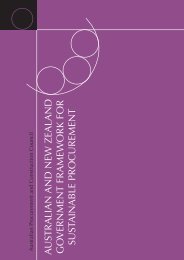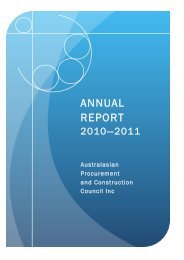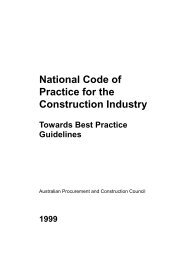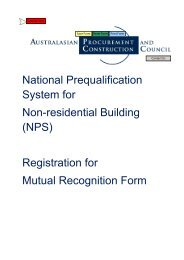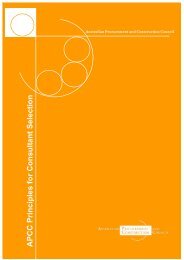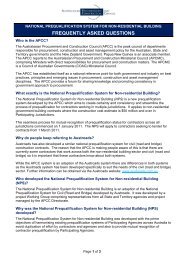Improving Security of Payment Building and Construction Industry
Improving Security of Payment Building and Construction Industry
Improving Security of Payment Building and Construction Industry
- No tags were found...
Create successful ePaper yourself
Turn your PDF publications into a flip-book with our unique Google optimized e-Paper software.
5. Pro<strong>of</strong> <strong>of</strong> <strong>Payment</strong> Page 69National Public Works Council Inc<strong>Improving</strong> <strong>Security</strong> <strong>of</strong> <strong>Payment</strong> in the <strong>Building</strong> <strong>and</strong> <strong>Construction</strong> <strong>Industry</strong>5.8.3 The problem <strong>of</strong> cash flow being held up because either a dispute exists between thePrincipal <strong>and</strong> the Head Contractor or the Head Contractor <strong>and</strong> a SubcontractorAs a result <strong>of</strong> the contractual framework upon which most building projects are based,ie where payment at one level is dependant on the provision <strong>of</strong> a statement to theeffect that payment at a lower level has been made, any dispute as to whetherpayment has been made or should be made will have repercussions up <strong>and</strong> down thecontractual chain.The use <strong>of</strong> pro<strong>of</strong> <strong>of</strong> payment approaches should provide for alternative disputeresolution to "quicken up" the resolution <strong>of</strong> the dispute <strong>and</strong> accordingly, "quicken up"the flow <strong>of</strong> monies through the contractual chain. Alternative dispute resolutionwould provide a mechanism for sorting out disputes <strong>of</strong> this nature. The critical <strong>and</strong>probably most fundamental point concerning the implementation <strong>of</strong> alternativedispute resolution is that the mechanism must settle the dispute as soon as possible,bearing in mind the cashflow problems that would otherwise result. Thus, the quickerthe dispute is identified <strong>and</strong> referred to alternative dispute resolution, the quicker itwill be resolved <strong>and</strong> cashflow restored. Essentially, this will be determined by theadministrative efficiency <strong>of</strong> the framework adopted to conduct the alternative disputeresolution.5.8.4 In the Queensl<strong>and</strong> Build Approach if the Head Contractor advises the Principalthat certain Subcontractors have failed to sign acknowledgments, two possibilitieshave been posed:(i)(ii)the Principal advises the Subcontractor that payments to the HeadContractor are to be made <strong>and</strong> the Subcontractor is free to take whateveraction he sees fit; orthe Principal withholds monies due to these Subcontractors until thedispute is resolved ie until the Subcontractor signs the acknowledgment".The first possibility would appear to be a laissez-faire approach, allowing thePrincipal to extricate itself from the dispute. Furthermore, the approach seems to bein direct conflict with presumption that no payment is to be made by the Principal tothe Head Contractor until the acknowledgment is received.We do not believe such an approach should be adopted.The second possibility appears to be more in accordance with the presumptionbehind the acknowledgment mechanism. Nonetheless, it would be still necessary tosort out the dispute as soon as possible, bearing in mind the ramifications <strong>of</strong>cashflow problems should payment not be made. With the Principal withholding themonies or with the use <strong>of</strong> an escrow mechanism, where security <strong>of</strong> the monies ismaintained whilst they are in dispute, monies will not end up in the Subcontractor'sh<strong>and</strong>s either at all or within any satisfactory time limits unless the dispute isresolved.



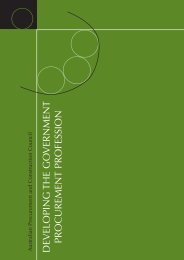
![NATIONAL COST ADJUSTMENT PROVISION EDITION 2 [NCAP2]](https://img.yumpu.com/48266135/1/184x260/national-cost-adjustment-provision-edition-2-ncap2.jpg?quality=85)

